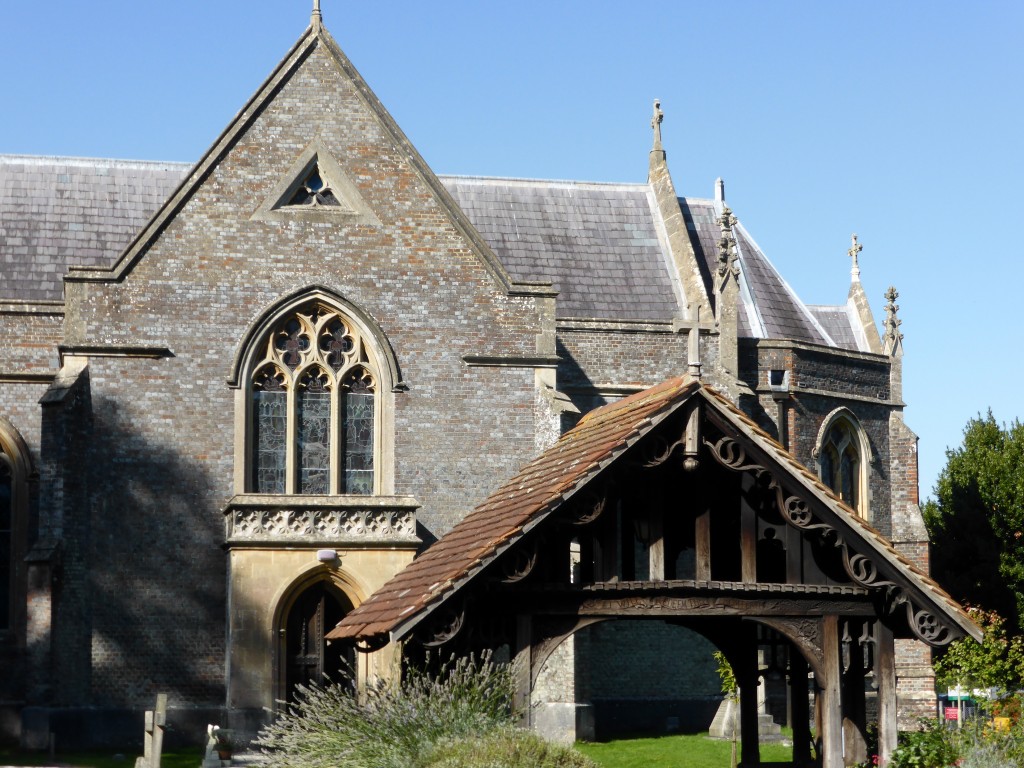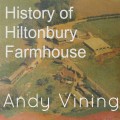Charlotte Mary Yonge? Who is she?
She is the woman represented by the new statue of a seated figure in the approach to Eastleigh Railway Station. Yes, but who is she?
Charlotte Mary Yonge is hardly known these days but she was a notable novelist in her time. She lived in Otterbourne all her life from 1823 until 1901. Her house was on Otterbourne Hill and is now used as a hostel for recently released prisoners. A former occupant of the house, from before it was a hostel, researched Charlotte Mary Yonge in depth but I have been unable to find any record of hers.

Charlotte was educated by her father and gave him lifelong devotion.
Charlotte is known to the literati as an important and prolific Victorian female novelist. Her first work was Heir to Redclyffe published in 1853 and proved very popular. Her novels always featured a strong Anglican moral thread. She was, after all, the Sunday school teacher. It is said of her writings that she ‘made virtue interesting.’ Her work is central to an understanding of the development of the domestic novel.
As well as novels she produced “The Monthly Packet”, a magazine aimed a Anglican girls. Among her non fiction works was A History of Christian Names and early and serious work in this field.
I never read any Charlotte Yonge but some of her works are available on Kindle for no cost.
Friends and admirers
Among her admirers were Charles Dickens, William Morris, Charles Kingsley, Tennyson and Edward Burne Jones (Southampton Art Gallery has a good collection of EBJ’s paintings). She was very friendly with John Keble, who became vicar of All Saints, Hursley in 1835 -1866.

She had strong connections with the Coleridge family. It is unlikely that she knew Samuel Taylor Coleridge (Kubla Khan and Rime of the Ancient Mariner) well as he died in 1835. His granddaughter Alice Mary Coleridge was Charlotte’s god daughter, and his other granddaughter Christobel Coleridge was Charlotte’s amanuensis for many years.
John Coleridge Patteson was a good friend and a church missionary. He was killed by Solomon Islanders in 1871. There were pirates and slave traders around at the time and Patteson got caught up in the troubles. He was not eaten but his body was covered in leaves then set afloat on the sea in a canoe.

Church and the Oxford Movement
In 1868 the Parish of Otterbourne was created and Charlotte donated £500 towards St Matthew’s Church.

Through her friendship with John Keble, Charlotte Yonge was part of the Oxford Movement. These days we might refer to the Oxford Movement as Christian Fundamentalism. They, the Oxford Movement members, must have felt betrayed when one of their leaders, John Henry Newman, defected to the Roman Catholic church and subsequently became a cardinal.
The Oxford Movement was a kind of ritualistic and theological dead end. It probably did more harm than good. One good thing to say about it is that John Henry Newman’s poem, The Dream of Gerontius, inspired Elgar to write his last great choral work of the same name.
Some say that the devil has the best tunes; no he doesn’t. You cannot fail to be moved by the choir and orchestra swelling into the chorus “Praise to the Holiest in the height,” The rest of Gerontius is pretty good too, musically. The subject matter of the poem is dire.
Keble and his College
Keble College in Oxford was built in memory of John Keble. Rated by many as the ugliest college in Oxford but actually quite comfortable to stay in compared with some others. It is a typical Victorian brick building, quite unlike the traditional colleges.

Keble College has a portrait of Christ by William Holman Hunt, ‘The Light of the World.’
A story I heard about the painting was that it was gifted to St Paul’s, London. It became so famous that the Dean decided to charge people to see it. William Holman Hunt was disgusted and painted it again for Keble College where it could be seen for free. Today I understand that the St Paul’s one is free to view. Keble’s is free to view but you have to pay to switch on the lights, (and you do need the lights to see it!)
If ever we won a prize at Sunday School it was a postcard of this painting. Not until I saw the originals did I realise how poor the postcards were.
What is your opinion?
What do I think about the statue? Better her than that other local worthy, Benny Hill. We could have had, and maybe one day we will, a statue of RJ Mitchell, designer of the Spitfire. Sir Isaac Newton is said to have lived in Cranbury House for a while – now there is a famous name.
Other events around Charlotte Mary Yonge’s time
- Jane Austen 1775 -1817
- Samuel Taylor Coleridge 1772-1834
- Cardinal Newman 1801 – 1890 (Appointed Cardinal 1879)
- 1835 King William IV reigns. Robert Peel, Prime Minister.
- 1837 Queen Victoria
- 1839 Eastleigh Railway Station opened
- 1860 Dickens ‘Great Expectations’. Abraham Lincoln selected as presidential candidate. HMS Warrior launched and still afloat in Portsmouth.
- 1891 Eastleigh Railway works
- 1901 Death of Charlotte Mary Yonge and Queen Victoria.
Charlotte Mary Yonge – ‘Godmother’ of Eastleigh
Note: These notes below are by Joanne Calcutt of the Implementation and Design Office of Eastleigh Borough Council.
Throughout her career the profits from various novels were used to fund charitable works. In 1868 a new parish was formed to the south of Yonge’s home village of Otterbourne containing the villages of Eastley and Barton. Yonge donated £500 towards the parish church (Church of the Resurrection) and was asked to choose which of the two villages the parish should be named after. She chose Eastley, but decided that it should be spelt ‘Eastleigh’ as she perceived this to be more modern.

Eastleigh developed rapidly with the explosion in industrial development brought by the railways. Eastleigh Railway Station opened in 1839. From being a small village, Eastleigh had to accommodate hundreds of immigrant workers and their families, and Yonge was at the forefront of charitable endeavours to develop good housing and facilities for them. In fact, local people remembered her as a great benefactress, much more than as a novelist.
Charlotte gave so much to the town, and to literature, during her lifetime that it seemed fitting to recognise her in some way. Funded using developer’s contribution, Eastleigh’s new sculpture was created by a very talented artist – Vivien Mallock using reference material supplied to us by the Charlotte Mary Yonge Fellowship.
In Vivien’s interpretation Charlotte is around 45 years old, as this is how old she was when she named Eastleigh. We hope that the sculpture will increase awareness of the work of Charlotte Mary Yonge and Eastleigh’s history more generally.
More information see Charlotte Mary Yonge Fellowship and Eastleigh’s Heritage. Another useful source is Eastleigh museum.

Eastleigh Borough Council: Mayor of Eastleigh welcomes Charlotte Mary Yonge
Charlotte Yonge, who named the town, is seated outside Eastleigh Station https://t.co/x4572UcLRA pic.twitter.com/KBOGRqZSjm
— Eastleigh Borough (@EastleighBC) September 28, 2015
Note on 8th November 2015: After the post had been published, I received an email in late October from Dr Clemence Schultze, Chair of Charlotte M. Yonge Fellowship.Dear Dr Sedgwick,
Thank you for your query via Charlotte Mary Yonge Fellowship email and the link to your interesting blog.
“St Matthew’s Church at Otterbourne was built in 1838-9 by William Crawley Yonge, Charlotte’s father. The church to which CMY donated the large sum of £500 was certainly the Church of the Resurrection, Eastleigh. Her interest in this church is attested in some of her letters of 1867 and 1868, see especially:
- To Alexander Macmillan
- Alexander Macmillan to Charlotte Mary Yonge
- To Robert Brett
- To the Reverend Arthur Rawson Ashwell
- To the Reverend Arthur Rawson Ashwell – 2
and this note gives brief details about the church.
I cannot offhand recall what the documentary evidence is, for the specific figure of £500, but am pretty sure it is sound.”
Never miss out on another blog post. Subscribe here:






Thank you, Mike, this is a lovely article. I wonder what Miss Yonge would make of the town now – she wouldn’t recognise it, I’m sure.
An interesting fact to add is that she’s mentioned in Louisa May Alcott’s ‘Little Women’ – or rather, one of her novels is. Jo March is reading ‘The Daisy Chain’ as part of her self-improvement efforts!
Jo is also discovered in chapter 3 crying over “The Heir of Redclyffe” in the attic. I can’t remember the bit where she is reading the “Daisy Chain” – can you remind me?
Hi
Just been in Eastleigh Library and they have a stand about Miss Yonge.
There are some books in Eastleigh Library about Miss Yonge including:
Chaplet For Charlotte Yonge and Charlotte Yonge and Otterbourne School, 1872-1901
Woodcock, Lloyd Eastleigh and District Local History Society, 1987
Special Paper No.17 and The Journal of the Eastleigh & District, History Society Eastleigh & District Local History Society, September 2014
Am I imagining it, or was that statue in Twyford road a year or so back?
There is some family story that one of my forebears was one of the workmen who built Keble College.
Eastleigh Borough Council has said this statue is a new one – a “new Charlotte”.
See discussion on Streetlife.
Nobody has commented on the discrepancy in the article. Did Charlotte contribute £500 to St Matthew’s church Otterbourne or to the Church of the Resurrection in Eastleigh. This is the church that was burnt and eventually converted into apartments.
I contacted the Charlotte Mary Yonge Fellowship for clarification but have not had a reply so far.
Miss Yonge couldn’t have contributed £500 to St Matthew’s Otterbourne as it was completed in 1838 when she was 15. It must have been the Church of the Resurrection.
I should have added that I’m the secretary of the Charlotte Mary Yonge Fellowship.
I’m almost three years late with this, but as we were driving by Eastleigh Station we noticed the statue. I suspected that it may have been of Charlotte Yonge.
She was, as you say, a distinguished Victorian writer and I have no objection to her being commemorated, but it does occur to me that another seat on the bench could be reserved for William Panter, who largely spearheaded the creation of the town we now know as Eastleigh.
Panter was born in Castlethorpe in Buckinghamshire in 1841, the eldest son of Barnabas Panter, who was an engine driver. The family soon moved to Wolverton, where the young Panter received his schooling and was apprenticed as an engine fitter in 1853. He was clearly very bright and able and rose through the ranks to become works manager. In 1885 he was recruited by the L&SWR as Superintendent at Nine Elms in London. His great task was to oversee the transfer from Nine Elms to new facilities in Eastleigh and the new railway works and town opened in 1890.
Thanks for your very informative comment, Bryan. It’s never too late to comment on this site!
I hope you enjoy reading the rest of the website.
Thank you for your comment. I know nothing of Panter, nor anything much about the development of the railway in Eastleigh. It would be good to have some posts on the history of Eastleigh, I know it is way over the other side of the motorway but we all go there to shop a few times a week. Perhaps Bryan, you could write something for us.